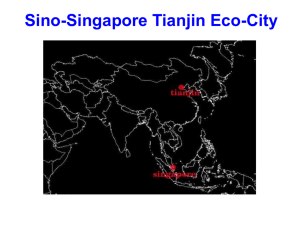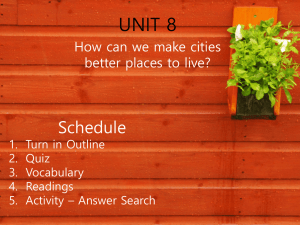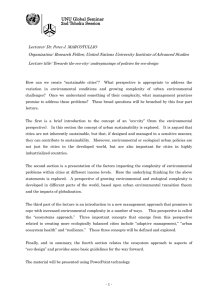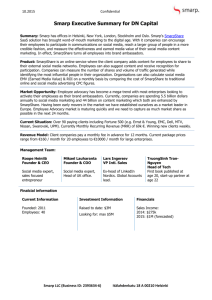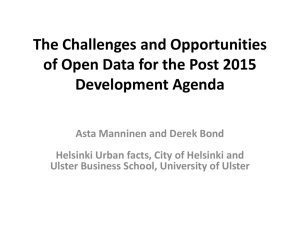Sustainable Cities-fact sheet-eng-final
advertisement
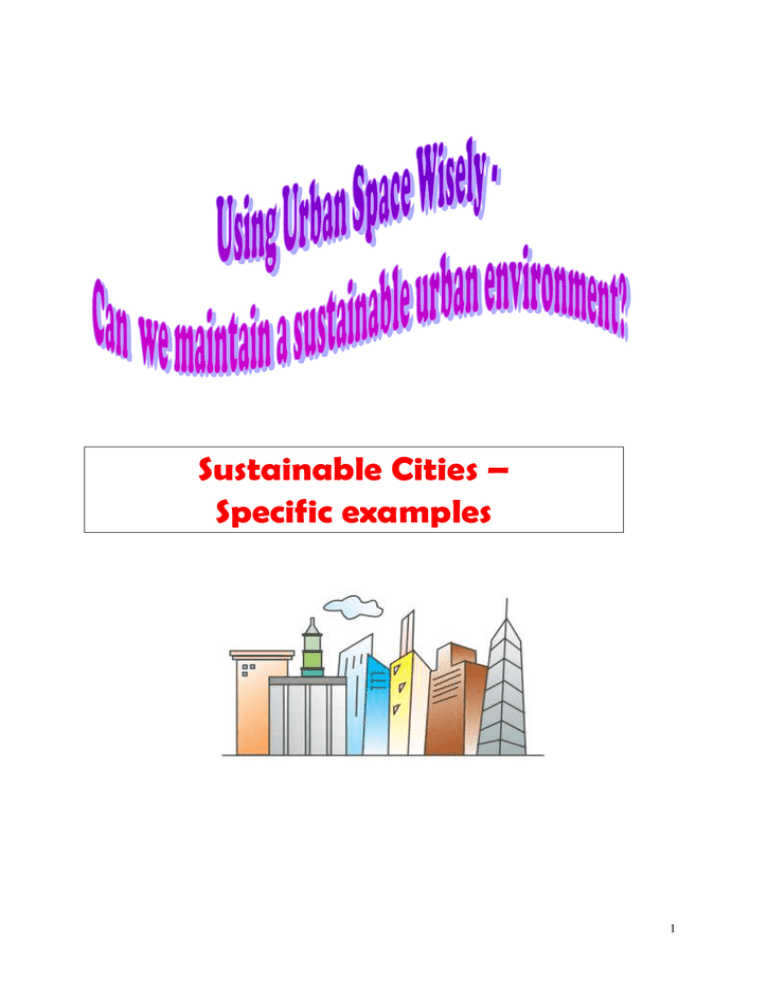
Sustainable Cities – Specific examples 1 I. Purpose of using these specific examples in this module 1. 2. These specific examples are chosen to give students a brief introduction on how urban problems can be solved by adopting the concept of sustainable development in urban planning and management. They can strengthen students’ global perspective and enable them to have a better understanding of what is happening in other parts of the world. II. Catering for learner diversity 1. 2. For students with average ability, it is advisable for teachers to give just a very brief overview of what are happening in other cities and how they try to solve their urban problems in a sustainable way. For those with better ability and interest in urban geography, teachers can consider comparing the case of Hong Kong with those of Guangzhou/Tianjin, or even a multiple-case comparison including Seoul and Helsinki. III. How to make use of the information provided in this folder? 1. 2. 3. The information given in this folder provides a detailed description of each specific example. Teachers can have an understanding of the background of the kinds of urban problems that these cities are facing and how sustainable urban planning and management have helped to solve these problems. Teachers need not teach all the information provided in this folder and should tailor-make them and choose which example(s) they should use according to the ability and interest of the students. Teachers can make use of the materials for the following activities: Background information for students’ discussion on the degree of sustainability on individual city; Information provided for comparing the cases of different cities; Materials for self-study. 2 Sustainable development, according to the World Commission on Environment and Development, is: "development that meets the needs of the present without compromising the ability of future generations to meet their own needs." “Our Common Future, 1987” Sustainable development for Hong Kong means: finding ways to increase prosperity and improve the quality of life while reducing overall pollution and waste; meeting our own needs and aspirations without doing damage to the prospects of future generations; and reducing the environmental burden we put on our neighbours and helping to preserve common resources. “1999 HKSAR Governor Policy Address” Reference: Sustainable Development – the Government of the HKSAR http://www.susdev.gov.hk/html/en/sd/index.htm 3 URBAN21 Conference (Berlin, July 2000) define sustainable urban development as: “Improving the quality of life in a city, including ecological, cultural, political, institutional, social and economic components without leaving a burden on the future generations.” Characteristics of a sustainable city 1. Cambridge Local Agenda 21 sets five objectives for a sustainable city: increasing social equity and creating a fairer society encouraging participation, so that everyone can voice their opinion 2. improving living space maintaining healthy environment conserving natural resources In 1996, United Nations’ report “President’s Commission on Sustainable Development” set up guiding direction of sustainable development in different countries. It stated that the planning should be far-sighted to 20, 50 or even 100 years. While planning and designing, we must do the overall consideration and take the traffic, land use, housing, community development, economic development and environmental protection as a whole. Efforts are suggested to be made on the following aspects: Have compact and efficient land use planning Have good accessibility and reducing car use Use resources efficiently and reduce the amount of pollution and waste Strengthen ecological protection and restoration Preserve local traditions and culture as well as the unique social relations between people and between people and land References: 1. Lau S Y Stephen, Platten A K, Lau T Erica, Wang Jun (eds) (2009). International Sustainable and Urban Regeneration Case Studies and Lessons Learned 2008: ICONUS Conference 08. Hong Kong: Hong Kong College of Technology 2. Regional Environmental Center http://archive.rec.org/REC/ Programs/SustainableCities/What.html 3. Witherick M. & Adams K (2006). Cities & Urbanisation. Great Britain: Philip Allan Updates. 4 General Information A. Geographical location It is the provincial capital of Guangdong Province. It is located on the southeast part of Guangdong Province and the northern edge of Zhujiang Delta. Longitude: 112o57’ – 114o3’E; Latitude: 22o26’ – 23o56’N B. Total area 7434.4 km2 C. Population 12.7 million (2010) Population density: 1708 / km2 Transport problems in Guangzhou Guangzhou is a rapidly developing city. Its GDP has risen from RMB 320.4 billion in 2002 to RMB 1060.4 billion in 2010. In terms of GDP, Guangzhou is next only to that of Shanghai and Beijing. With such high rate of economic growth, the city has attracted many immigrants. Rapid urbanization creates many urban problems, such as the lack of careful landuse planning and unsatisfactory traffic management. 5 The followings were some of the transport problems faced by the city in the past decade: 1. The close economic connection between the urban area and the peripheral areas resulted in a huge volume of passenger and goods transport was tremendous. 2. The total length of roads in the urban area was 1908 km and the road area was 2302 m2 by the end of 1998 with an average road space of 5.75 m2 per capita. However, there was a shortage of road capacity and there was little space for expansion. So there were many black spots of traffic congestion. 3. There was a rapid growth in the ownership of motor vehicles. By the end of 1998, the number in the urban areas was 621,000 of which 61.9% was motorcycles. 4. Private vehicles (mainly motorcycles) have taken a very high proportion (up to 50%) of all traffic modes. Public transport accounted for only 17.5% of the total number of trips in 1998 and the service level of public transport was far from satisfactory. 5. The layout of the bus route network was not quite rational and some of the routes were seriously overlapped. There were too few bus stations. The metro line No.1 was in operation but its effect in releasing the transport pressure was still limited. 6. There was a serious shortage of parking areas in the city centre and existing facilities could only meet half of the demand, which led to serious illegal parking. 6 2011 Sustainable Transport Award Winner: Guangzhou, China In order to reduce the negative impact of the transport problems in Guangzhou, city planners have developed the Bus Rapid Transit (BRT) system. This bus system has its own dedicated bus lanes on streets. It uses bus stations instead of bus stops, a design which requires passengers to pay before boarding the bus. This allows faster and more orderly boarding. Because of this system, Guangzhou has won the 2011 Sustainable Transport Award. It is an award given to the city that made most progress to increase and improve mobility for all residents while reducing transportation greenhouse and air pollution emissions, and at the same time improve safety and access for cyclists and pedestrians. The Guangzhou BRT which opened in 21 February 2010 transported more than 23,000 passengers per hour. At a cost of US$6 million per km, the BRT is 10 times cheaper than a subway. Walking still makes up 40% of all trips, but in a city where a third of trips are by bus, the BRT will reduce travel times, saving more than 40 million passenger-hours annually. Buses are operated in a direct service mode which means that the buses come in and out of the BRT corridor without passengers needing to transfer, to stop at the end and to transfer to another line. The size of the stations varies. For example, in the city centre where the demand for transport is great, the stations are big, maybe more than 240m long. The stations in the suburban area are small, only 16 m. 7 The buses used are LPG vehicles (Euro III or higher). All stations are full-weather protected and the environment is enhanced. It is also connected to the Guangzhou Metro (廣州地鐵)at three stations. In order to promote cycling to connect this system, there are segregated bike lanes lined with trees along the main corridors. There are also bike parking and bike sharing facilities in the BRT stations. The system is operated by seven operating companies in three large corporate groups to ensure good services. The following are some of the features of the Guangzhou BRT: Total: 26 stations (1 more to be added in late 2011). 42 bus routes operated in the corridor. BRT vehicle fuel: LPG A smart card system. Total length of dedicated busway lane: 22.5 km Location of busway lane: Centre of roadway Peak throughput (passengers/hr/direction): 27,400 System passenger-trips per day: 805,000 Average bus occupancy (peak hour & direction & point): 78 Urban area inhabitants (million) served: 13 Public transport mode share (%, including walking): 30 5500 bike parking spaces at stations (planned) (first in China) 5000 rental bicycles at stations (planned) Infrastructure cost per km (million yuan): 30 8 Please refer to the following website for the photos of the BRT Guangzhou: http://www.chinabrt.org/en/cities/guangzhou.aspx Map of the BRT References: 1. China FAQs – The Network for Climate and Energy Information “China Looks to Bus Rapid Transit Systems to Cope with Rapid Urbanization” www. Chinafaqs.org/blog-posts/china-looksmbus-rapid-transit-systems-cope-rapidurbanization 2. Feng Wang & An Jin (2000) Traffic demand management in Guangzhou city for the 21 st Century in 《2000 年學術會議》論文集 www.chinautc.com/information/manage/UNCC_Editor/uploadfile/年會論文/06 交通管 理發展與對策/52Traffic%20Demand%20Management%20in%20Guangzhou%20 City %20for%20the%2010st%20c.pdf 3. Guangzhou and a Glimpse into the Future: Changing China http://carbusters.org/2009/11/03/guangzhou-and-a-glimpsee-into-the-future-changingchina 9 4. Guangzhou BRT www.chinabrt.org/en/cities/guangzhou.aspx 5. Guangzhou China www.guangzhou.gov.cn 6. Guangzhou, China: Winning the future with BRT www. streetfilms.org/Guangzhou-china-brt 7. Guangzhou, China, Wins Sustainable Transport Prize http://news.nationalgeographic.com/energy/2011/01/110124-guangzhou-china-sustainable -transport-prize 8. Selling in China – Guangzhou http://www.hktdc.com/info/mi/a/bgdscn/en/1X069VKV/1/Guide-To-Selling-in-China/Se lling-in-China-–-Guangzhou--.htm 9. Sustainable Urban Transport Project www.sutp.org/index.php?option=com_content&task=view&id=2549&Itemid=1&lang=en 10. 沿海城市 GDP 排名爭奪日趨激烈 廣州憂天津追上 www.hkcd.com.hk/content/2011-02/22/content_2692316.htm 10 “Green Community” in Guangzhou A. The idea of “Green Community” With increasing rate of urbanization and the promotion of sustainable development as one of the key elements in the policy of the Chinese government, the Ministry of Environmental Protection has proposed the construction of model city on environmental protection and green community at local level. The “green community” is a community that targets on maintaining the good quality of the socio-ecological environment and the balance of the ecosystem which in turn promotes the harmonious development between human and the natural environment. This can be achieved by establishing a reasonable mode of consumption and lifestyle by the residents living there. Starting from 2001, the local government of Guangzhou has set up clear objectives and concrete actions in the building of “green community”. Local communities or districts are encouraged to develop or redevelop their area according to the principles of the “green community”. District interested can apply for authentication as “green community”. Self assessment and assessment by local government will be carried out according to the criteria listed below: There is a well-organized environmental management system to achieve the targeted level of environmental quality. This system should also provide training for all personnel involved, not just government officials but the general public too. The quality of the environment and the level of pollution should be monitored closely. There should be certain amount of greenery in the area. The tidiness, cleanliness and hygiene of the district should be maintained. Natural resources, including animals and plants should be protected and preserved. 11 Residents in the district are encouraged to have green consumption. They should use clean energy and participate in activities on environmental protection. There should be the promotion of environmental protection and awareness among the public through different means or activities. B. Achievements in Guangzhou 1. Up to 2010, there were 259 green communities in Guangzhou. One example is in Liwan District (荔灣區). There were 24 “green communities” which contributed to 1/5 of the total number of communities in the district. In these communities, 100% of the solid waste has been treated. The area of greenery covered 25% of the area in the communities. Over 90% of the public has participated in environmental protection and over 90% of the residents satisfied with the environment in the district. 2. There is a greater concern over the control of pollution level. Starting from 2010, stricter control is imposed over the level of noise. All new construction next to residential area, hospital or schools must lower the noise level by building noise barrier. There is also strong monitoring on solid waste treatment. 3. More green areas were built in the city. In 2010, the areal coverage of greenery in the built-up area was 35.5%. The greenery area per capita was 15.01m2. The length of road with greenery was 1060 km which was the longest, the largest coverage and serving the largest population among all cities in the province. 4. Citizens in Guangzhou become more aware of environmental protection as a result of the strong promotion and education from the local government. Citizens began to adopt a green lifestyle and develop a greater concern over their environment. 12 References: 1. 2002 年廣州市“綠色社區”創建工作總結 (2003 年 12 月 31 日) www.gzepb.gov.cn/root43/gov/200810/t20081015_1751.htm 2. 2010 年廣州市環境保護工作總結及 2011 年工作計畫 (2011 年 9 月 6 日) www.gzepb.gov.cn/was40/dertail?record=6&channelid=5785&searchword=%C2%CC% C9%AB%C9%E7%C7%F8 3. 廣州市綠色社區考評標準 www.gzepb.gov.cn/zwgk/gs/lssq/200906/t20090626_59004.htm 4. 廣州荔灣區:群眾參與的“綠色社區”之路 www.epi88.com/master/News_View.asp?NewsID=950 5. 積極推進廣州綠色社區建設 www.gzzx.gov.cn/cf114/dhwj/201004/1474.html 13 General Information A. Geographical location It is one of the four municipalities directly under the governance of the Central Government of China. It lies in west of the Pacific Ocean, the northeast of the North China Plain(華北平原), at the lower reaches of Haihe (海河), with Bohai (渤海) on its east and Yanshan (燕山) on its north. It is only 137 kilometers southeast of Beijing, the capital of China. Latitude: 38°34'N-40°15'N; Longitude: 116°43'E-118°04'E B. Total area 11760 km2 C. Population 12.9 million permanent residents (2010) Population density: 1097 / km2 Reference: 1. Tianjin Municipal People’s Government http://www.tj.gov.cn/english/About_tianjin/Visiting_Tianjin 2. City Population – China – Tianjin http://www.citypopulation.de/China-Tianjin.html 14 Challenges faced by typical Chinese city: A Driving Need for sustainability As a rapidly developing country, China faces a lot of challenges towards sustainability. The 2005 Environmental Sustainability Index (ESI), which ranks countries based on such measures as health, governance, technology, and international cooperation, placed China 133rd out of 146 countries. The following shows the different aspects of concern: A. National Demographics The urban population of China is expected to grow rapidly in the coming years. It is expected that every year, 20 million people will become city residents. Every year, at least 15 million young laborers start looking for jobs, out of which 6 million University graduates looking for white collar job. B. Resources Water: 2200m3/person in China, less than 1/4 of global average level. Arable land: 933m2/person, less than 40% of global average level. Energy: China’s city used 149 gigawatt hours of electricity per billion RMB of production (2008) which was much higher than other cities like New York (11 gigawatt hours) and Mexico City (10 gigawatt hours). C. Environment Air: Only 20% of China’s cities meet the WHO’s standards for sulphur dioxide and nitrogen dioxide, and almost none meet the standard for particulate matter. Water: The polluted fresh water per person is more than the average of developed countries. Wetlands: Seaside wetland areas have been reduced by 50% in the last 40 years. 15 D. Society Income gap: Average income at the level of Japan 40 years ago and internal difference is 31 times. Reducing social inequities is the major goal. Nearly 100 of the cities studied in China had metropolitan densities of about 4000 people/km2 which is higher those of some cities in developed countries, such as New York (1800) and Paris (3300). Sino-Singapore Tianjin Eco-city As China has faced such challenges of sustainable development, the Chinese government would like to explore ways to cope with these problems. In 2007, the Senior Minister Goh Chok Tong of Singapore and the Premier Wen Jiabao of PRC agreed to jointly develop an Eco-city in China. In November 2007, Tianjin was chosen as the location for the Eco-city. It is a bilateral project between China and Singapore with private-sector investment and development (50/50 joint venture). Its aim is to create a model demonstrating the determination of both countries in reconciling global climate change, strengthening environmental protection, resource and energy conservation, and building a harmonious society. 16 A. Location of Sino-Singapore Tianjin Eco-city The total area of the Eco-city is 34.2 km2. It is located at the coastal area 40 km from Tianjin city centre and 150 km from Beijing. The site is 10 km from the core district of the Tianjin Binhai New Area (TBNA) (天津濱海新區), and a 5-10 minute drive from the southern tip of the site to Tianjin Economic-Technological Development Area (TEDA) (天津經濟技術發展區). Site of Tianjin Eco-city 17 B. Concepts underlying the planning and development of the Tianjin Eco-city The key concept is the ‘three harmonies” – man living in harmony with man, now and for future generations; man living in harmony with economic activities; and man living in harmony with the environment. It adopts a holistic approach which starts at the macro-level – comprehensive master planning integrating land use and transport planning, to ensure those living and working in the Eco-city have a good living and working environment. Residents also have good access to facilities. Land use planning has been integrated with public transport network to encourage more green transport and less use of private vehicles. There is also land use that facilitates economic development so as to create adequate well-paying jobs for residents. There is also good water and waste management, use of renewable energy and the construction of green buildings. Strong and cohesive communities within the Eco-city are fostered. Residents living there also need to play a role in realizing the vision of the Eco-city. For example, they need to be prepared to walk, cycle or use public transport and not to use private cars in the Eco-city. Human Environment Economy Balanced harmony 18 C. Key Performance Indicators guiding the planning and development of the Eco-city 1. Good Natural Environment Ambient air quality Quality of water bodies within the Eco-city Quality of water from taps Noise pollution levels Carbon emission per unit GDP Net loss of natural wetlands 2. Healthy balance in the man-made environment Proportion of green buildings Native vegetation index Per capita public green space 3. Good lifestyle Habits Per capita daily water consumption Per capita daily domestic waste generation Proportion of green trips Overall recycling rate Access to free recreational and sports amenities Waste treatment Barrier-free accessibility Services network coverage Proportion of affordable public housing 19 4. Developing a dynamic and efficient economy Usage of renewable energy Usage of water from non-traditional sources Proportion of R&D scientist and engineers in the Eco-city workforce Employment-Housing equilibrium Index D. Features of the Eco-city In order to address to the challenges of sustainable development, the Eco-city has adopted a holistic and balanced approach in the planning and development of the city. The following are some of its features: 1. Energy Efficiency and Use of Clean and Renewable Energy Renewable energy, such as solar and geothermal energy, is used and shall account for at least 20% of energy utilized by 2020. 2. Green Buildings All buildings in the Eco-city will conform to green building standards to ensure efficient energy usage. 3. Green Transportation There will be an efficient and easily accessible public transport system. The target is for at least 90% of all trips within the eco-city to be taken by walking, cycling or public transport (green trips). 20 4. Ecologically Friendly Estuary wetlands and biodiversity will be preserved. At least 70% of the plant varieties are indigenous. Green spaces and recreational facilities are within walking distance of 500 m. Public green space per capita will be more than 12 m2 by 2013. Air quality shall meet China’s National Ambient Air Quality Grade II standard for at least 310 days/year. Noise pollution shall 100% meet the standard of respective functional area. 5. Water Management The city has low rainfall and water supply from rivers draining the area is not enough to meet its needs. At least 50% of the fresh water supply for the Eco-city will come from desalination and recycled water by 2020. Others come from water plants from Tianjin Economic-Technological Development Area (TEDA) and Hangu (漢沽). Daily water consumption per person per day shall not exceed 120 litres by 2013. To ensure a high quality of living environment, tap water will be potable and shall meet the PRC and international standards. The quality of surface water bodies will be treated so that it can meet Grade IV of China’s latest national standard. 21 6. Waste Management The “3Rs” of waste management – Reduce, Reuse and Recycle – will be adopted. Domestic waste generated per person shall not exceed 0.8 kg and 60% of total waste should be recycled by 2013. Non-organic waste will be recycled and reused and organic waste will be used as biofuel. 7. Economic Development The Eco-city will specialize in tertiary and service industries and will be an educational and R&D centre for environment-related technologies. There shall be at least 50 R&D scientists and engineers per 10,000 workforce by 2020. Good employment opportunities will be provided for its residents. At least 50% of the employable residents in the Eco-city shall be employed in the Eco-city by 2020. Centre for eco-education, training & research institutes will be set up to provide skilled labour. Carbon emission per unit GDP shall not exceed 150 tonne-C per US$1 million. 22 8. Social Harmony 20% of the houses in the Eco-city will be subsidized so that residents of different income levels and professions can live there. Communal amenities and facilities will be highly accessible. The Eco-city will be barrier-free to cater for the needs of the elderly and mobility-impaired. An energy-conservation and environment-friendly mindset will also be cultivated among the residents. For example, residents will be prepared to walk, cycle or use public transport instead of using private cars. 9. Heritage Conservation Local heritage will be preserved, for example, the Ji Canal with 1000 years of history, will be retained. Progress of the Project Up till September 2011, about 300km2 land development has been completed. They included: * 500 residential housing blocks (conform to green building standard) * Social facilities including schools, hospitals and community services 2 * About 300 m green area and 40km green roads The whole project is expected to be completed by 2020. At that time, the population is projected to be 350,000. 23 References: 1. Developing a city of the future: Sino-Singapore Tianjin Eco-city www.siww.com.sg/pdf/08_Developing_a_city_of_the_future_Sino_Singapore_Tianjin_ Eco_city.pdf 2. Sino-Singapore Tianjin Eco-city www.tianjinecocity.gov.sg 3. Sino-Singapore Tianjin Eco-city to pilot first of its kind eco manufacturing base in China www.tianjineco-city.com/en/news_center/press_release/928.aspx 4. The Urban Sustainability Index: A New Tool for Measuring China’s Cities www.urbanchinainitiative.org/wp-content/uploads/2010/11/usi.pdf 5. 6. Tianjin: A model Eco-city in the Eastern World http://sustainablecities.dk/en/city-projects/cases/tianjin-a -model-eco-city-in-theeastern-world 7. 中新天津生態城 www.eco-city.gov.cn/eco/shouye/main.html 8. 中新生態城首批居民年底入住 鹽鹼灘上建綠世界 http://tjeco-city.com/cn/news_2.asp?<=&action=RecordDetail&kind=2008031815311000 00C0A801B03040&id=2011092818110900003C1E1C498647 24 General Information A. Geographical location Seoul is the capital of South Korea. The city is some 30.3 km from north to south and 36.78 km east to west. It sits in a natural basin surrounded by a number of peaks of 500 meters or more above sea level. Latitude: 37°34'N; Longitude: 126°59'E B. Total area 605.41 km2 C. Population 10.4 million (2010), about a quarter of the population of the Republic of Korea. Population density: 17,240/ km2 References: Hi Seoul, Soul of Asia http://english.seoul.go.kr/gtk/main.php 25 Cheonggyecheon Restoration Project, Seoul A. Background Cheonggyecheon (清溪川)is a stream flowing through the centre of Seoul from east to west, then meeting Jungnangcheon, which in turn connects to the Han River and enters into the Yellow Sea. In the past, the stream was an integral part of the lives of the Seoul residents who used it for laundry, recreation and waste disposal. However, the stream frequently flooded after heavy rain, causing lots of damages. During the Japanese occupation, many farmers moved to Seoul because they lost their farmland. They began to build illegal houses along the banks of Cheonggyecheon. Increasing population polluted the stream and turned it into the breeding bed for infectious diseases. Frequent flooding also threatened the people living along the banks of the stream. Therefore, there were voices calling for the decking of the stream. In 1958, the full-scale work to deck the stream began. In 1971, the Cheonggye Road, which was 50-80 m wide was built to cover up 6.27 km of the stream. Under the road, there were sewage drains, water pipes, sewage pipes, electric power ducts, telecommunications ducts and gas lines. The area next to the road housed over 100,000 small businesses. In 1976, the Cheonggye Elevated Highway, 16 m wide and 5.8 km long, was built. The heavy traffic brought by the Highway replaced the dirty water with exhausted fume. By the end of the 20th century, the buildings beside the road were old and shabby. The area was polluted with little green space. 26 B. Why was there a need for the restoration of the river? 1. The safety of citizens was threatened In 1991, a safety evaluation of the Cheonggye Elevated Highway found that the structures were corroded and damaged which might threaten the safety of the citizens. This was the result of the accumulation of heavy metals such as lead, chromium and manganese at the bed of Cheonggyecheon originated from the heavily polluted stream water. The corrosion of the structures was further accelerated by carbon monoxide, methane gas and other gases trapped underground. Since the long-term stability of the structures could not be ensured, the government started to formulate a solution to the problem. 2. Concern to ease the transport problem in the city centre In the 90s, there was a decrease in the use of public transport by the people living in Seoul owing to unsatisfactory service and poor planning and management. More than 168 thousand cars use Cheonggye Road and Cheonggye Elevated Highway every day. Illegal parking was common. Pedestrian volume in the downtown was more than 2000 persons per day but there was lack of pedestrian crossings. The situation was further worsened by the heavy traffic of motor cycle on the sidewalks. There was an urgent need to alleviate this problem. 3. A need to transform Seoul into a human-oriented and environment-friendly city The project marked a major paradigm shift of the Korean government in urban planning, moving from ‘development’ orientation to ‘human’ orientation. One of the major aims is to improve the quality of life of the Seoul citizens and transform Seoul into an environmentally friendly city, offering a liveable environment that is people-centred. 27 4. Revitalizing the neglected city centers The neighborhood around the Cheonggyecheon Stream was mainly old buildings 40-50 years old. The area was a slum in a deteriorating condition. 75% of total buildings in the urban centre have less than four stories and 53% of the structures were made of wood or brick. The restoration of Cheonggyecheon will stimulate urban redevelopment. Important industries, such as international financing, the cultural industry, and the fashion and tourism industry will be attracted. This can raise the competitiveness of Seoul as an international city. 5. Recovering Seoul’s history and creating cultural spaces Seoul is a city with 600 years of history. It helps to rediscover its historical roots and original look which have long been forgotten. C. The Restoration Project The project started in 2003 by the Seoul Metropolitan Government and was completed in September 2005. It is a project which helps to revitalize the downtown area in the southern part of Seoul. The area will be developed into a historical and cultural centre, a business and commercial centre and a centre of tourism and shopping. The project includes the following: 1. Restoration of the stream The Cheonggye Elevated Highway and the structures covering the Cheonggyecheon Stream were removed. The stream was restored as an ‘urban stream in nature’, a human-oriented, environment-friendly urban space with a waterfront and sidewalks along the banks. Embankments which can withstand flood that is expected to occur every 200 years were built. Terraces and lower-level sidewalks were built along the 28 upper and lower reaches of the stream. Intercepting sewage lines were installed to collect rainwater and wastewater separately. Covering structures were used in some part of the stream in order to prevent wastewater from flowing into Cheonggyecheon during periods of heavy rainfall. 2. Water supply Cheonggyecheon is an intermittent stream. Water is drawn daily from the Han River, underground water and the purified water from the Ttukdo Water Purification Plant. The average water depth is 40 cm and 120,000 tons of water flows through Cheonggyecheon each year. 3. Waterfront roads and access road Both sides of the stream are wide as much as at least 13.5m to accommodate one-way two lane roads, sidewalks and loading/unloading space for smooth traffic flow. The restored stream is accessible at 17 locations. There are 5 pedestrian bridges and 17 bridges for motorists to cross the Cheonggyecheon. 4. Restoration of ecological environment The waterfront is planted with plants that grow well along bodies of water to create natural scenery. Some parts of the waterside are restricted from access by citizens, and are created as green areas for insects and birds. At the downstream section, a swamp and habitats for fish and birds is created. 5. Restoration of history and culture of the place The restoration project recovers the artefacts of historic heritage and restores the pride of the Korean people in their 600-year old city. “Cultural belts” which are special routes for walking, sightseeing and shopping are designed. These make Seoul become a cultural city for all citizens to share and enjoy. 29 D. Is the Project sustainable? In 2005, Seoul City has won the World Technology Award organized by the World Technology Network (WTN) in San Francisco for its restoration technology. WTN gave the prize to Seoul because the city committed its effort to restore the asphalt-covered downtown stream and to carry out effective public transportation reform. The following are the achievements of the project: 1. To avoid serious traffic congestion that might cause by the demolition of the Cheonggye Elevated Highway and the narrowing of the Cheonggye Road, the city office built a new temporary parking lot in Dongdaemum stadium and provided free shuttle bus service from the Stadium to the inner city. Bus-only lanes were introduced to allow public transportation to have priority in using the roads. As a result, more people began to use buses and subway trains. Car owners were restricted to use their cars once every 10 days. As a result, congestions seldom occurred during the construction period and the traffic condition of the city improved with the completion of the project as more people chose to use public transport. 2. The project can fulfil the objective of public participation. As the project involved many merchants and residents in the area, there were many public hearings and presentation sessions so as to involve the participation of the parties involved. Measures were devised to address the complaints relating to inconveniences to businesses and to find ways to stimulate business activities which was composed of different business quarter. A large comprehensive distribution complex which housed wholesales and retail shops, support facilities such as a distribution centre, a large-scale discount store and a multiple movie theatre was built in the southeastern part of Seoul. Most of the street vendors along Cheonggyecheon have moved to Dongdaemum Stadium and a new unique market has been built there. 30 3. The ecosystem along Cheonggyecheon has been greatly enriched. The number of fish species increased from 4 to 25, bird species have multiplied from 6 to 36 and insect species from 15 to 192. 4. The removal of the highway reduced air pollution. The concentration of particulate matter / suspended particulates along the corridor dropped from 74 micrograms per cubic meter to 48. 5. The stream tends to cool down the area and the greenery has the effect of lowering the summer temperature by 2-5oC than those of the nearby area. 6. The ecological park built along the stream banks attracted some 90,000 pedestrians visit on an average day and an estimated 18.1 million visitors by the end of 2008. 7. The neighbourhood of Cheonggyecheon is developed into a center of international finance and business which increased the nation’s global competitiveness. The prices of land near the stream have increased by almost 50% after the restoration project. Map of Cheonggyecheon 31 More photos: http://english.sisul.or.kr/grobal/cheonggye/eng/WebContent/index.html http://english.sisul.or.kr/grobal/cheonggye/tchinese/WebContent/index.html References: 1. Cheonggyecheon Restoration Project www.wfeo.org/documents/download/cheonggyecheon%20Restoration%20Project_%20K orea.pdf 2. Cheonggyecheon Restoration Project http://webarchive.nationalarchives.gov.uk/20110118095356/http://www.cabe.org.uk/case-s tudies/cheonggyecheon-restoration-project 32 3. Cheonggyecheon Restoration Project to create huge economic, environmental values http://english.seoul.go.kr/gtk/news/reports_view.php?idx=1120 4. Restoring Cheonggyecheon Stream in the Downtown Seoul http://www.globalrestorationnetwork.org/uploads/files/LiteratureAttachments/270_restorin g-cheonggyecheon-stream-in-the-downtown-seoul.pdf 5. Seoul: Life beneath the asphalt http://sustainablecities.dk/en/city-projeccts/cases/seoul-life-beneath-the-asphalt 6. Seoul won WTN prize for environment http://english.seoul.go.kr/gtk/news/news_view.php?idx=352 7. The New York Times – Asia Pacific – Peeling back pavement to expose watery havens www.nytimes.com/2009/07/17/world/asia/17daylight.html?_r=1 33 General Information A. Geographical location Helsinki is the capital and largest city in Finland. It is located in southern Finland on the shore of the Gulf of Finland. The city spreads across a number of bays and peninsulas and over a number of islands. Latitude: 60°10'N; Longitude: 24°56'E B. Total land area 213 km2 C. Population 588,941 (2011) Population density: 2739/km2 References: 1. City of Helsinki – Annual Report 2009 www.hel.fi/wps/wcm/connect/4474d2004a17412c81d8e93d8d1d4668/Hel sinki_vuosikertomus2009_eng.pdf?MOD=AJPERES 2. Facts about Helsinki 2010 www.hel2.fi/tietokeskus/julkaisut/pdf/tasku09_englanti_net.pdf 3. Helsinki City Info 4. www.helsinki.com/v/city_info World Organization Prospects: The 2009 Revision Population Database http://esa.un.org/wup2009/unup/p2k0data.asp 34 Finland Sweden Helsinki Norway North Sea Denmark Baltic Sea United Kingdom Location of Helsinki 35 Model of Green City – Helsinki Helsinki is considered as one of the cleanest city in Europe. It rates high in public health and sanitation condition. The drinking water is some of the best in the world. The city has such achievement because ever since 1990, it has already implemented environmental programme. In 1992, the United Nations Conference on Environment and Development adopted the Agenda 21, a long-term plan for sustainability. In 1997, Helsinki has actualized the Agenda 21 at a local level by launching the Local Agenda 21 (LA21). In 2002, the city has formulated Helsinki’s Sustainability Strategy and Action Plan. The plan contained strategic goals and guidelines for the enhancement of ecological, economic, social and cultural sustainability in Helsinki during the period 2002-2010. The overall targets of the action plan are: 1. 2. 3. 4. 5. 6. Reducing greenhouse gas emissions in order to combat climate change Protecting and fostering biodiversity Promoting economic development by strengthening the city’s commercial and industrial development Increasing the participation of citizens Preventing social segregation Fostering cultural diversity and improving the built-up environment 36 A. Achievements of the City In 2003, Helsinki was awarded a certificate of distinction in the European Sustainable Award competition. According to the European Green City Index 2009, Helsinki ranked seventh with a score of 79.29 out of 100. The European Green City Index seeks to measure and rate the environmental performance of 30 leading European cities. It takes into account of 30 individual indicators such as environmental governance, water consumption, waste management and greenhouse gas emission. The following are some of the achievements that Helsinki has accomplished. 1. Environmental governance According to the European Green City Index 2009, Helsinki ranked first in environmental governance. Its Sustainability Strategy and Action Plan 2002-2010 made it the first capital city in Europe to complete a full-scale sustainable development action planning process. 2. Town planning The guiding principle for town planning is to maintain a significant proportion of green areas. In 2009, parks have constituted for 36% of the land area. There are 47 nature reserves in Helsinki, making up a total of 620 hectares. The amount of green space per inhabitant is about 150 m2. Some old industrial and storage areas in the inner city have been redeveloped into new housing, office and service areas and seaside parks. All new residential areas will be linked with rail transport network. The network of bicycle lanes is extended to all neighbourhoods. 37 3. Efficient use of energy The city’s energy company Helsingin Energia is famous for its technology of co-generation – combined generation of electricity, district heating and cooling. By using this technology, 93% of the heating needed in the city is served by this district heating. District cooling achieves 5 times better energy efficiency than building-specific cooling system. The overall energy efficiency of this technology is very high too, about 90% of fuel energy. It can also reduce carbon dioxide emission and fuel costs by 40%. Moreover, the use of renewable energy in electricity generation is planned to be increased. Large offshore wind power plants have been installed in the Baltic Sea. It targets to increase the share of renewable energy from 6% in 2010 to 20% in 2020. The city has tightened the building regulations to require all new construction and renovation of buildings to meet the low-energy standards (100kWh/m2 for heating, cooling and electricity in blocks of flats). Eco-efficient housing units will be built in a district of Helsinki where solar energy and local biomass will provide a major part of the energy required in these housing units. 4. Air quality The city’s air quality has improved as a result of the introduction of district heating and cooling and the replacement of coal by natural gas for energy production. However, the carbon dioxide emission is relatively high, 6 tonnes per head (2009) which is higher than the average of 30 European cities (5 tonnes). This is a result from the heavy demand for heating and electricity consumption. 38 5. Efficient use of public transport The public transport system of Helsinki was ranked second in comparison of 23 European cities in 2009. About 30% of all trips of the city dwellers were made by car, 32% by public transportation, 29% on foot and 7% by bicycle. In the city centre, only 20% of all trips were made by car. It is targeted that the share of sustainable transport modes will be increased by 3% by 2012. The major public transport modes in the city are metro and commuter trains, supplemented by buses and trams. Metro and commuter trains are large carriers which use less energy per head than automobiles and release less exhausted fume. These systems will also be extended to cover the outer area of the city. Most buses run on diesel but a certain number are fuelled by natural gas. Cycling is also encouraged. The city ranked first with regard to the length of its cycling network among the European cities. It has committed to double the share of cyclists to all trips to 15% by 2020. More cycle paths will be built and pedestrian-only streets will also be extended in the city centre. 6. Waste Treatment a. Water treatment All waste water from Helsinki and some nearby areas is purified in an efficient central treatment plant before it is disposed into the sea by pipelines. The energy needed in the treatment process is generated by anaerobic decomposition of nutrients, which produces heat and biogas. Heat energy from the purification process is utilized for the generation of district cooling and heating. Remaining sludge is processed into soil compost. 39 b. Solid Waste treatment By 2009, the Helsinki Metropolitan Area produced about 300 kg of household waste each year. About 55% of the waste is recycled and reused. Compost made from organic waste is used for landscaping. Biogas is also collected from old landfills and waste treatment plants. The city also has introduced recycle programmes of paper, cardboard, metal, glass and biodegradable waste. Over 90% of the residents claimed that they recycle paper, nearly 80% recycle cardboard and 70% recycle glass waste on a regular basis. The government also enforced the producers and importers of such products as electrical and electronic appliances, used tyres, paper products and batteries to organize their waste treatment. 7. Enhancing environmental education and awareness Efforts to raise environmental awareness have been introduced, including operating nature schools, organizing environmental campaigns and seminars, and arranging walks in neighbourhoods. Eco-support activities are organized in all workplaces to improve environmental management, eco-efficiency and environmental awareness. Eco-supporters in work communities are appointed and trained to encourage environmental responsibility. In schools, environmental programmes have been planned to raise environmental awareness among students. 40 8. Strengthening social cohesion and citizen participation In order to achieve a mixed population structure, new districts will be developed on the principle of mixed land use – mixing housing with commerce and services, as well as mixing various types of housing to promote diversity. Young people are given opportunities to participate in planning their living environment. B. Future Challenges for the city The city still needs improvement in: 1. reducing traffic volumes, traffic noise and carbon dioxide emissions 2. protecting the Baltic Sea and decreasing harmful discharge into 3. 4. 5. 6. the coastal water reducing the volume of waste and further improving recycling and reuse of materials protecting the ecosystem and maintaining biodiversity reducing the use of non-renewable energy reducing the emission of carbon dioxide to combat climate change 41 References: 1. City of Helsinki – Annual Report 2009 www.hel.fi/wps/wcm/connect/4474d2004a17412c81d8e93d8d1d4668/Helsinki_vuosikert omus2009_eng.pdf?MOD=AJPERES 2. City of Helsinki – Environment http://en.uuttahelsinkia.fi/sections/5/environment 3. City of Helsinki – Environmental Protection www.hel.fi/hki/helsinki/en/Services/Housing+and+the+environment/Environment 4. City of Helsinki – Environmental Sustainability Issues and challenges in Helsinki 2010 www.hel.fi/wps/wcm/connect/7d593d004298169a9779bf4b956b8a55/Environmental+Sus tainability+-esite_nettiin.pdf?MOD=AJPERES&lmod=-918449852&CACHEID=7d593d 004298169a9779bf4b956b8a55 5. City of Helsinki – Housing and the Environment www.hel.fi/hki/helsinki/en/Services/Housing+and+the+environment 6. European Green City Index www.siemens.com/entry/cc/features/urbanization_development/all/en/pdf/report_en.pdf 7. ICLEI – Local Governments for Sustainability: City of Helsinki, Finland www.iclei.org/index.php?id=9318 42
